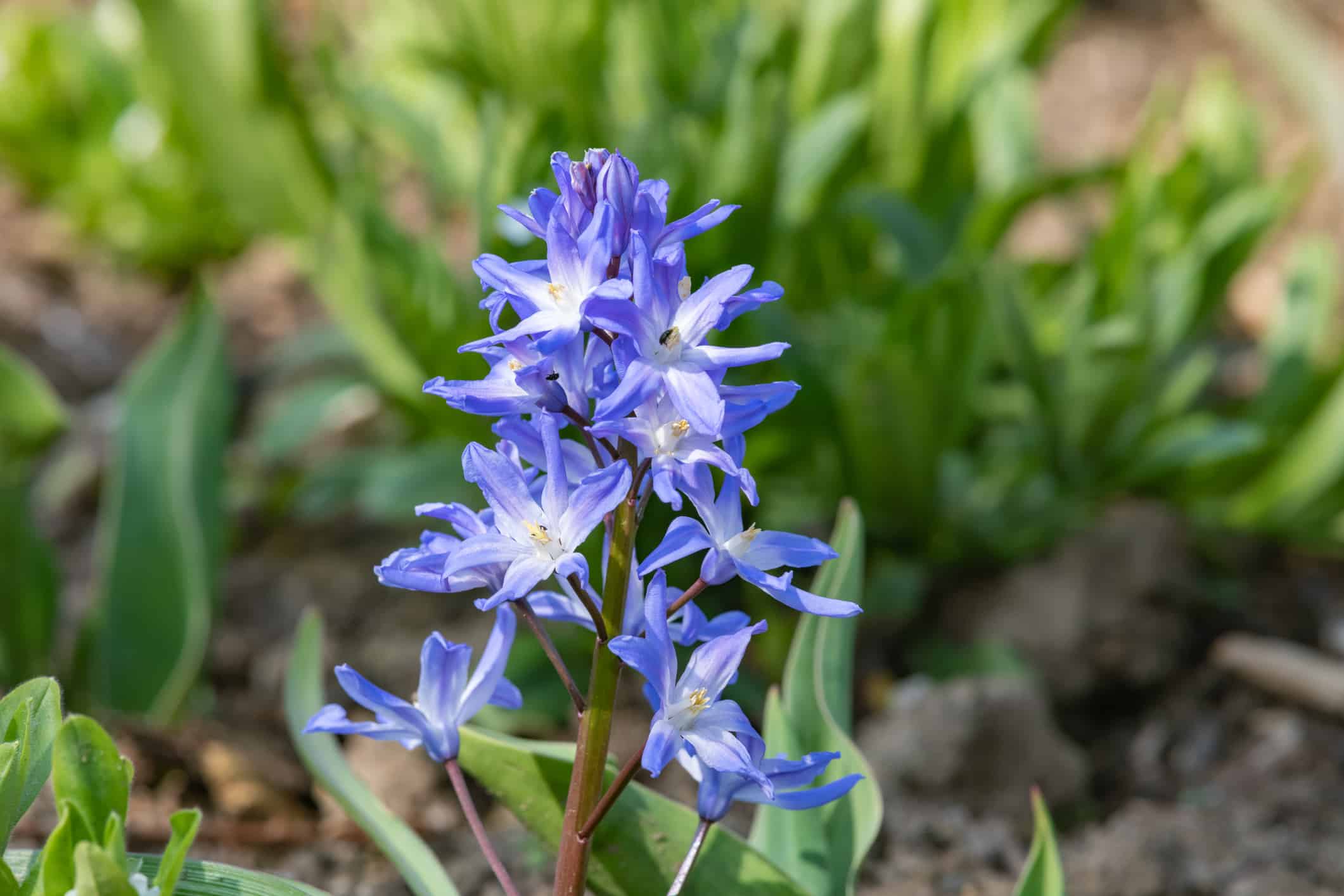The garden may be one of the most peaceful and charming places you can claim as your own, no matter where in the world you live. Even if you live in the city, a tiny patio or balcony garden can offer solace from the world. But choosing the right plants to grow can be challenging. Sometimes, you just don’t know where to start. In this case, we’re offering a list of flowers that start with G as an easy base line to search from. You’ll find beautiful, colorful, well-known blooms like gardenias and geraniums, as well as more unique options like the glory-of-the-snow or the Geum.
Take a look. You’ll find plenty to choose from among these 29 bloomers.
Gardenia (Gardenia jasminoides)

Gardenia (Gardenia jasminoides) blooms are highly fragrant.
©iStock.com/ANCHASA MITCHELL
The common Gardenia or cape jasmine, comes to the rest of the world from Japan and China. The stunning flowers not only look amazing, but they offer some of the sweetest, most distinctive fragrances you can come by for an easy-to-grow garden flower. The highly fragrant blooms come in white and grow up to 3 inches in diameter, either in clusters or as single blooms.
Geranium (Pelargonium)

There are 300 species of geraniums.
©Studio Photo MH/Shutterstock.com
Grown as either perennials or annuals, geraniums are some of the most popular garden flowers that start with G. They’re some of the most well-known flowers, as well, partially thanks to the nearly 300 species of the plant. The colorful blooms come in pale colors like white and pink, or deep shades of red, purple, blue, and others.
Gladiolus (Gladiolus palustris)
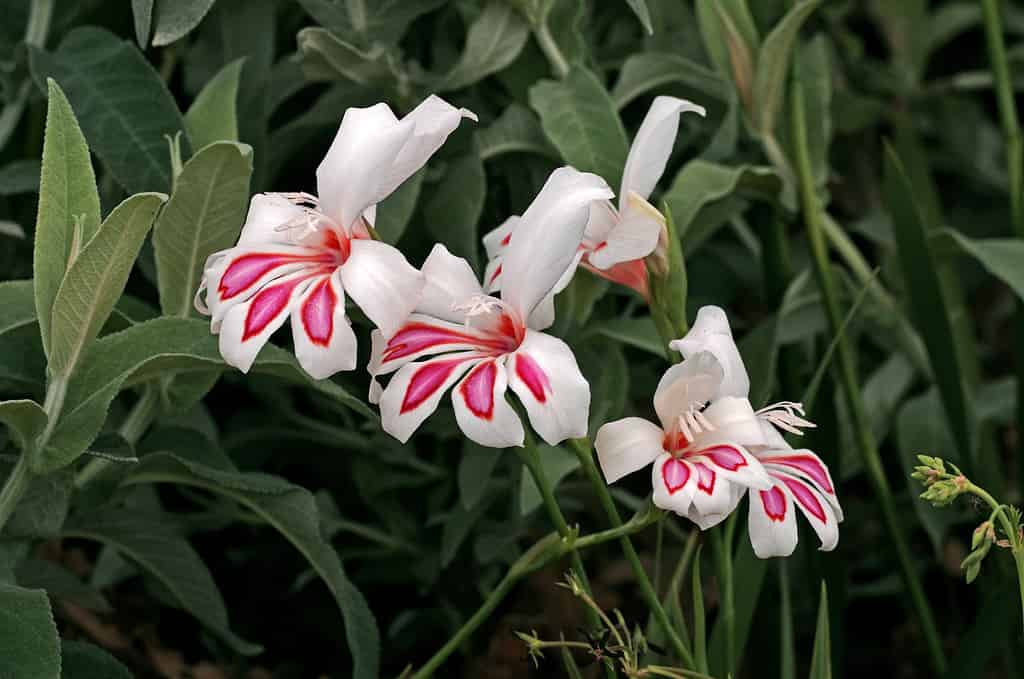
‘Prins Claus’ gladiolus and other flowers of the species are native to South Africa.
©Gardens by Design/Shutterstock.com
Gladiolus makes up a genus of around 250 bulb plants that grow natively in South Africa. The plants are also found in Northwest Africa, the Mediterranean, East Africa, and the Arabian Peninsula. Of course, they’ve been introduced all over the world. The beautiful flowers grow on spikes in many colors, including pretty much every color you can imagine. Pink, green, cream, white, peach, orange, yellow, purple, red, yellow, orange, and so many other colors can really add the variety you’re looking for in your garden.
Gerbera (Gerbera jamesonii)

There are 40 species of Gerbera daisies.
©fon.tepsoda/Shutterstock.com
Part of the daisy or sunflower family (Asteraceae), gerbera daisies are some of the most popular flowers that start with G. These stunning, simple flowers come in a huge array of colors and color forms, in 40 different species. The perennial plant is native to South Africa but has been introduced to much of the world, including the USA and Europe.
Goldenrod (Solidago sp.)
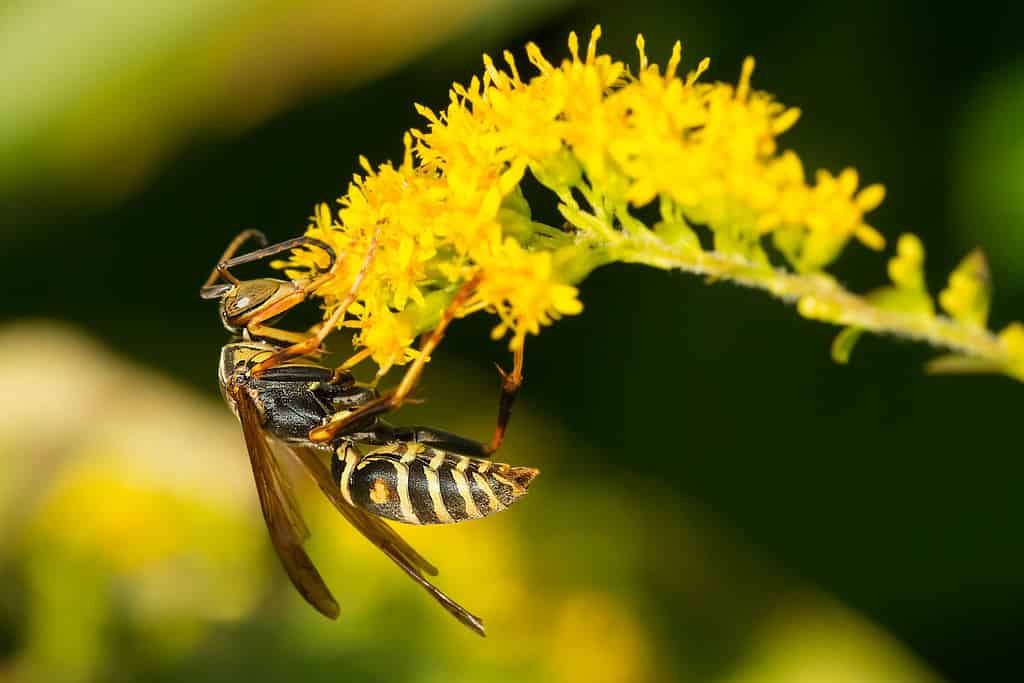
A Northern Paper Wasp collects nectar from a yellow Goldenrod flower.
©Paul Reeves Photography/Shutterstock.com
Spikes of tiny yellow-gold blooms pop out from the goldenrod plant, a wildflower in North America. They bloom at the end of summer, into the autumn, providing bees and butterflies food at the end of the season. Some folks confuse the flower with ragweed, but goldenrod doesn’t spread pollen like ragweed and therefore isn’t as likely to call allergic reactions. Goldenrod prefers full sun and moist, well-draining soil, though they can handle mild drought after they’ve become established.
Grape Hyacinth (Muscari)
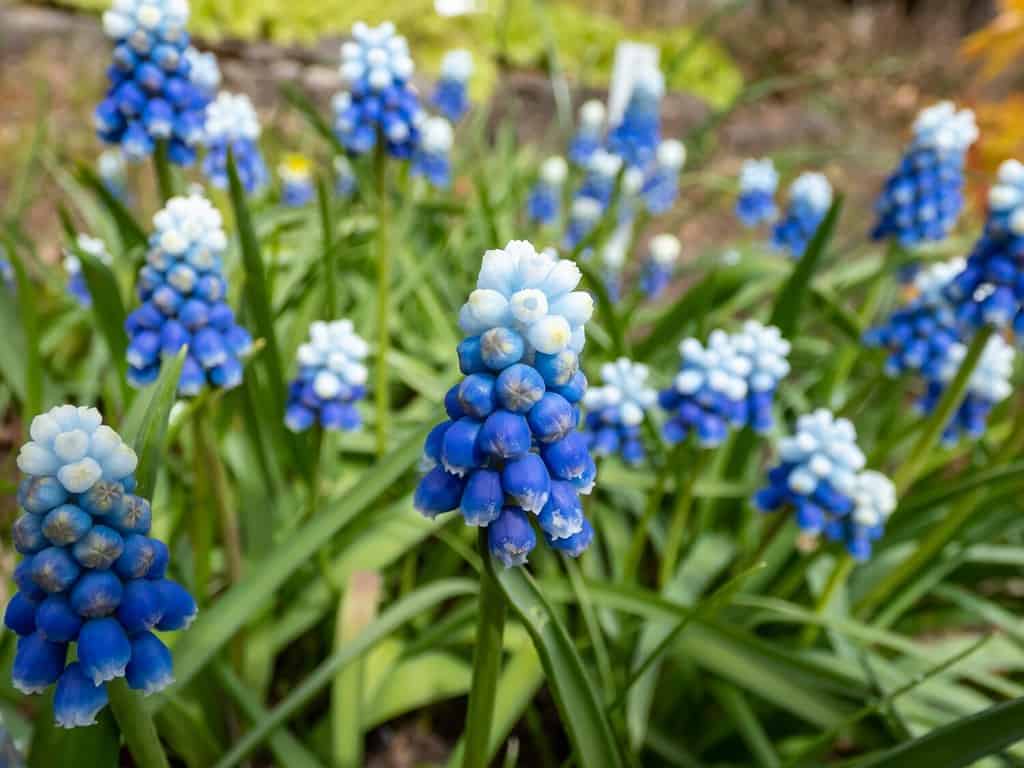
Bi-color grape hyacinth need well-draining soil, sun, and afternoon shade.
©Kristine Rad/Shutterstock.com
These beautiful blooms aren’t actually hyacinth, but they’re similar in appearance. Grape hyacinth come in white, purple, yellow, blue, or pink, with tiny flowers on spikes. They need well-draining soil and can easily grow either indoors or outdoors, as long as they have plenty of sun and afternoon shade. These glorious flowers have a sweet, grape-like aroma, which, with their unique looks, helps give them their common name.
Gaillardia (Gaillardia pulchella)
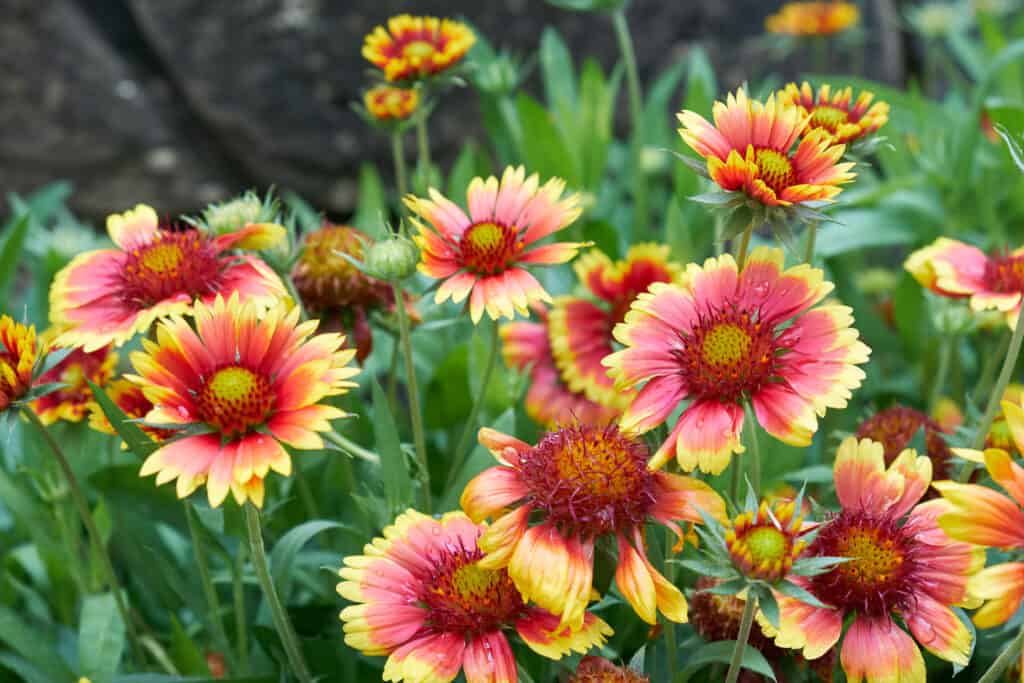
The Blanket Flower (Gaillardia pulchella) is the official flower of Wallondia in Belgium.
©iStock.com/Iseo Yang
Native to Missouri and other Midwestern states, Gaillardia comprises several species of flowers. The blooms come in red, orange, or yellow shades. You may also know the plant by the name Indian blanket. They look a bit like daisies, though most of them have stripes on the petals, radiating out from the central disks. The plants are hardy and heat tolerant, so they’re great for warm climates or for growing indoors, as long as they can get enough direct light.
Gas Plant (Dictamnus albus)
Also known as burning bush or dittany, Gas plants are beautiful, clumping perennial plants that pop out clumping flowers. The tiny blooms come in pink or white in the late spring to early summer. The reason for the name is the intense aroma put out by the leaves. It’s important to keep this plant away from the fire pit, outdoor fireplace, or any torches. The vapor they put out is actually flammable, which gives it the moniker of gas plant or burning bush.
Gaura (Gaura lindheimeri)
A perennial plant ideal for butterfly and bee gardens, Gaura is a beautiful choice of long-stemmed flowers that start with G. The delicate flowers at the end of the long stems show off pink and white flowers (or a mix of the two colors), drawing in pollinators of all sorts. The flowering plant is considered a perennial herb and grows as tall as 2 feet.
Gayfeather (Liatris)
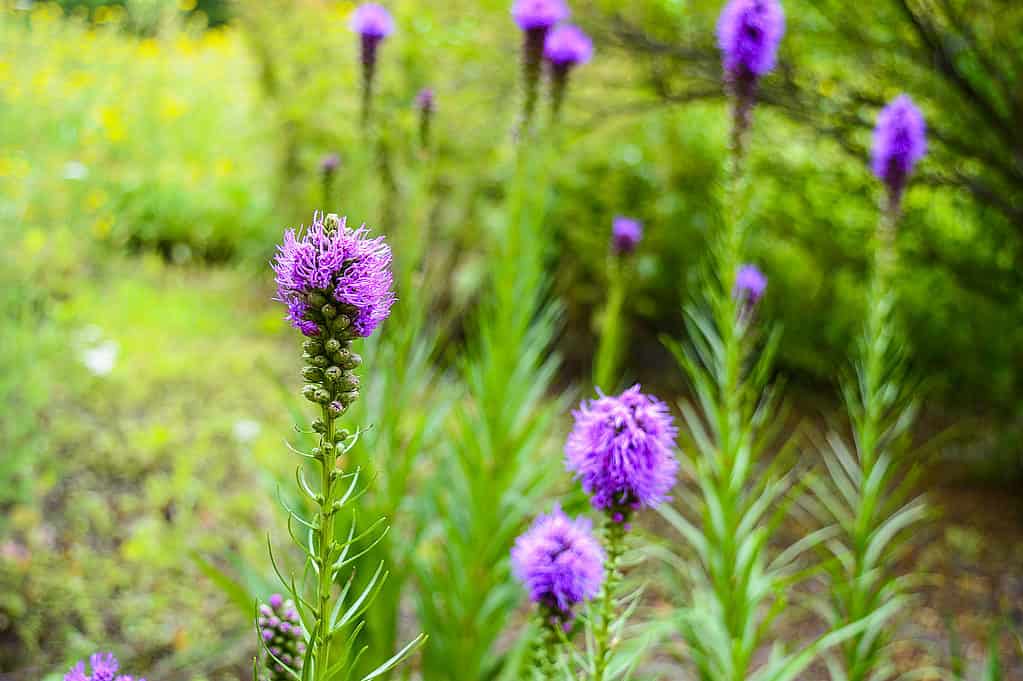
The pinkscale blazing star is also called the elegant blazingstar.
©agatchen/Shutterstock.com
Part of the sunflower or daisy family, the gayfeather flower perennial offers some gorgeous blooms that draw in pollinators. Other common names for the flower include Marsh Blazing Star, Blazing Star, or Dense Blazing Star. The beautiful plants grow erect stems with purple to pink spikes of flowers that those unfamiliar might mistake for lavender. Natively, the plants grow in low-lying wetlands, marshes, and grasslands. They make for amazing garden flowers, too, though, especially folks looking to attract bees.
Genista (Genista tinctoria)
Also known as dyer’s broom, cape broom, French broom, or Montpellier broom, Genista is a gorgeous perennial shrub. The plant is native to the Mediterranean, with yellow flowers of about a half-inch popping out all over them. The flowers grow in groups of 4 to 10 and look a little bit like balls of yellow instead of flowers.
Gazania (Gazania rigens)
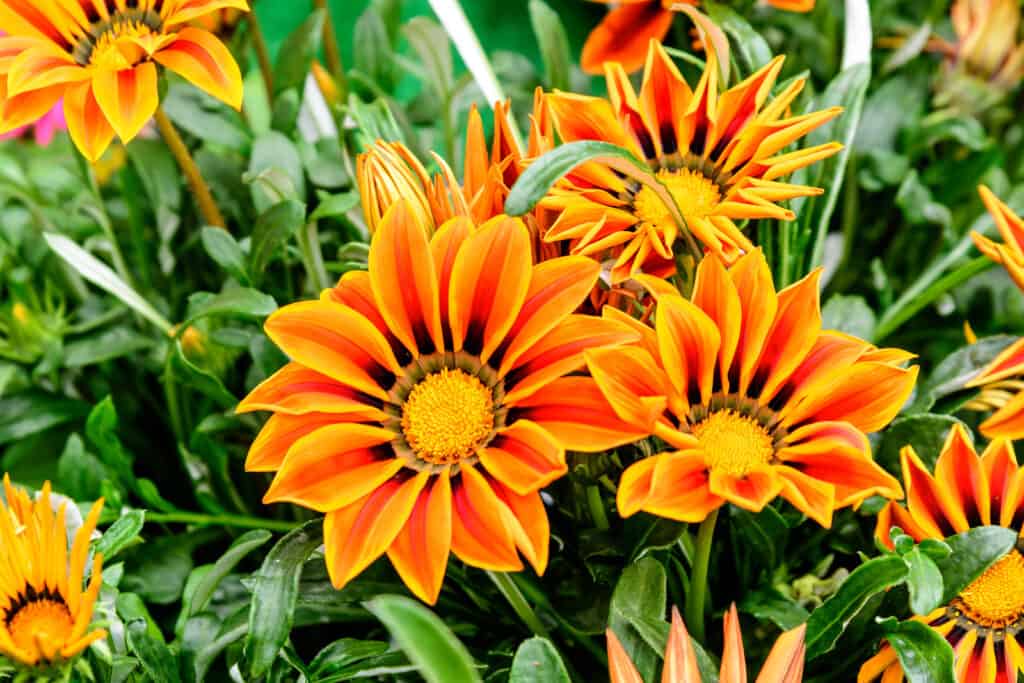
Vivid orange gazania flowers on a sunny summer day.
©iStock.com/Cristina Ionescu
If you need some flowers that start with G that tolerate heat and drought, look no further than the gorgeous Gazania flower. The blossoms come in bold orange with black eyes at the base or orange-brown discs. Hybrids of the flower come in other shades, including white, orange, yellow, and bronze. Plant them in areas that receive a lot of direct sunlight in your hot weather environs if you like, as long as you provide them with water sometimes. They can be perennials or annuals, depending on your Hardiness Zone.
Geum (Geum aurantiacum)

Geum Borisii is native to northern Turkey.
©iStock.com/Anna Bogdanova
Sometimes known as Avens, Geum flowers are less commonly used garden flowers than other perennials. The reason is that they simply aren’t as well known. The beautiful blooms look almost like a cross between a marigold and a poppy, with ruffled petals and vivid coloration in orange and red shades. The flowers have 5-leaf tips, branching stems, and clusters of yellow stamens at the center of 1.5-inch diameter blooms.
Ginger (Zingiber officinale)
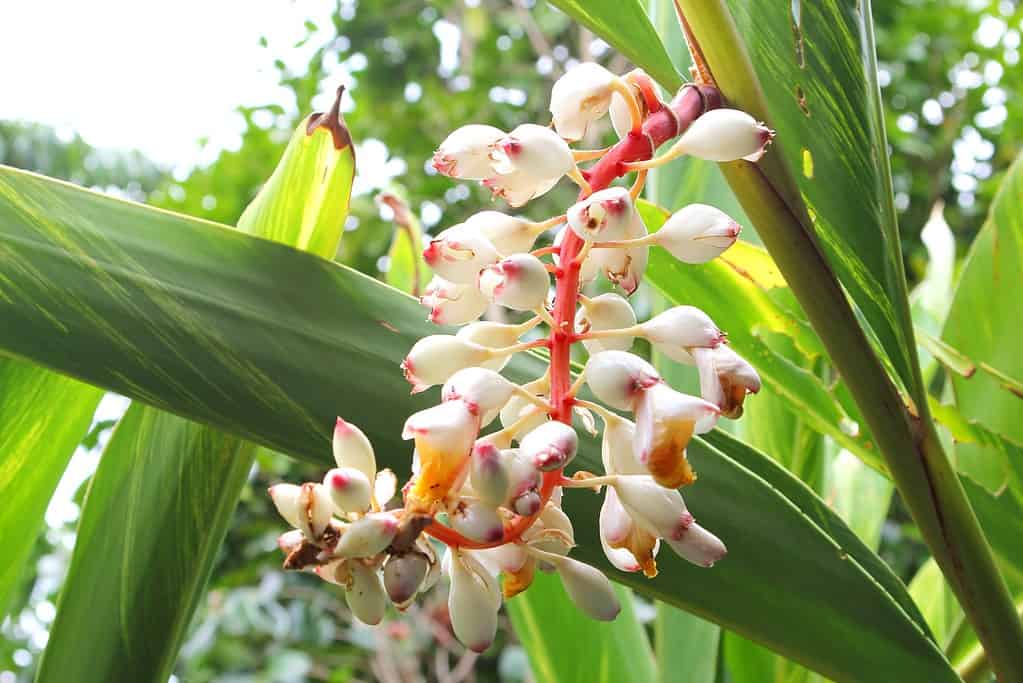
Ginger flowers grow from rhizomes.
©ingehogenbijl/Shutterstock.com
A perennial flowering plant, ginger plants can pull double duty in your garden. These flowers that start with G belong to the Zingiberaceae family, growing from rhizomes (similar to bulbs). The rhizomes are what most of us think of when we hear ginger – this is the root that we cut up and eat. The flowers of the ginger plant are dense and conical, growing in spikes. Plant them in the flower garden or herb garden and enjoy them for both.
Garden Stock (Matthiola incana)
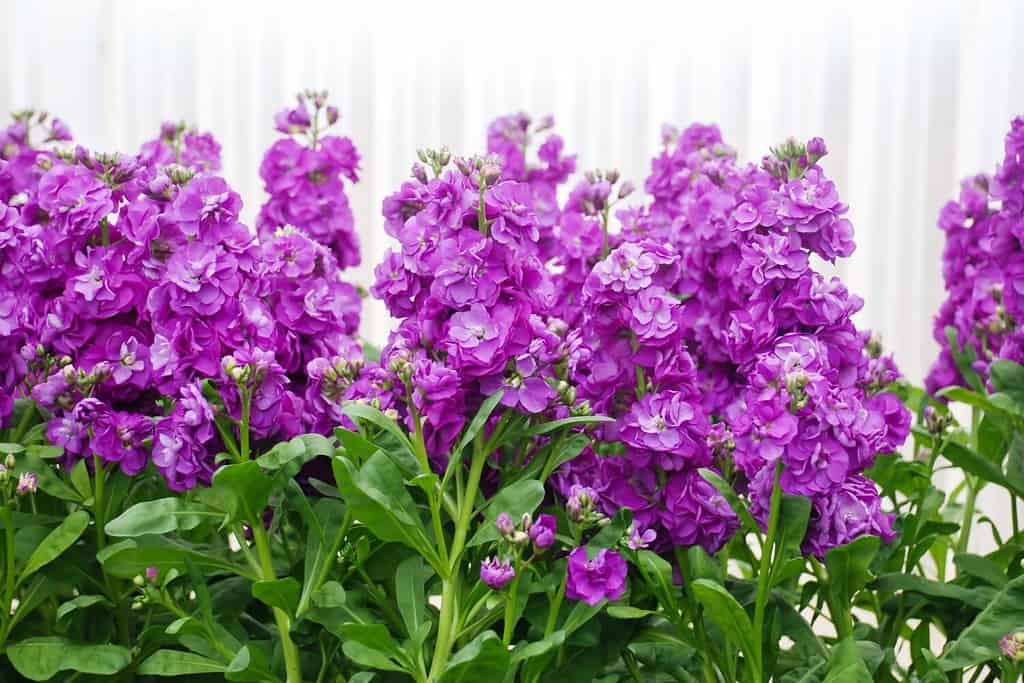
Known as garden stock, mathiola comes in a wide range of colors and is highly fragrant.
©Yui Yuize/Shutterstock.com
Often used for cottage gardens, garden stock offers fragrant blooms. A native of England, these flowers come in pink, red, white, or purple, in various shades. They love the cool spring weather and early summer months as annuals. In warmer climates, they may be a biennial plant, though, if properly cared for.
Globeflower (Trollius)
Favored as pond-side plants, Globeflowers are similar to ranunculus, just bigger and fuller. The flowers grow easily, with loads of blooms from late spring to early summer. The plants grow to 18 to 24 inches tall, with bright yellow, spherical flowers, which earns them gorgeous blooms their name. They’re perennials, so place them well, as they’ll come back year after year, as long as you care for them properly.

Globeflowers are similar to ranunculus.
©Mathias Pabst/Shutterstock.com
Glory-of-the-Snow (Chionodoxa forbesii)
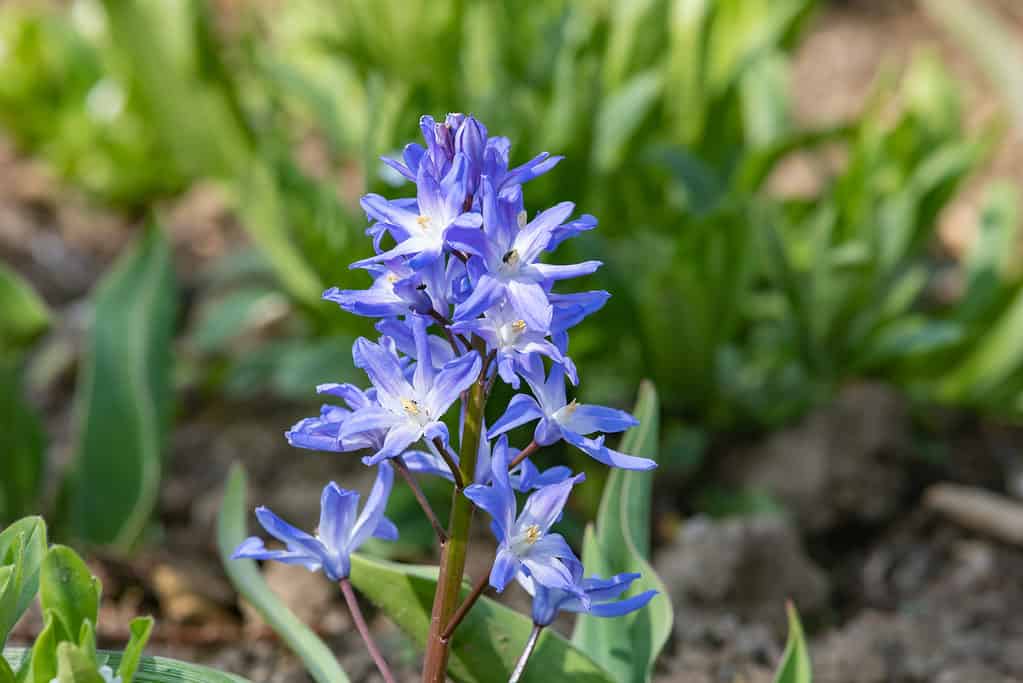
Glory-of-the-snow (Scilla forbesii) has glue flowers with white centers.
©iStock.com/Tom Meaker
Ever wanted to grow flowers that pop up through the snow? Consider the gorgeous flowers that start with G known as Glory-of-the-Snow. The beautiful blooms break through the winter blanket, showing off their gorgeous, pale blue flowers with a white-ish center. They look a bit like magical stars rising in winter to create a fairy tale mood.
Gloxinia (Sinningia speciosa)
Commonly referred to as Gloxoinia, Sinningia speciosa is a beautiful Brazilian flowering plant that comes from Brazil. With large trumpet-shaped blooms in lavender, purple, white, or red, and velvety texture, these beauties are a favorite for many reasons. Some varieties even resemble roses a little bit or have rippled petals that lend a certain magical mood to any flowerbed.
Godetia (Godetia grandiflora)
Godetia, also known as the satin flower, thrives in Hardiness Zones 3 to 10. The beautiful flowers that start with G make up 25 species of plants, each offering their own unique beauty to the world. These gorgeous bloomers come in a huge range of colors and shapes, including two and three-toned options, ranging from apricot, carmine, purple, orange, pink, red, and mauve shades (plus others), in sheer, sparkling, or pastel combos.
Gentian (Gentiana sp.)
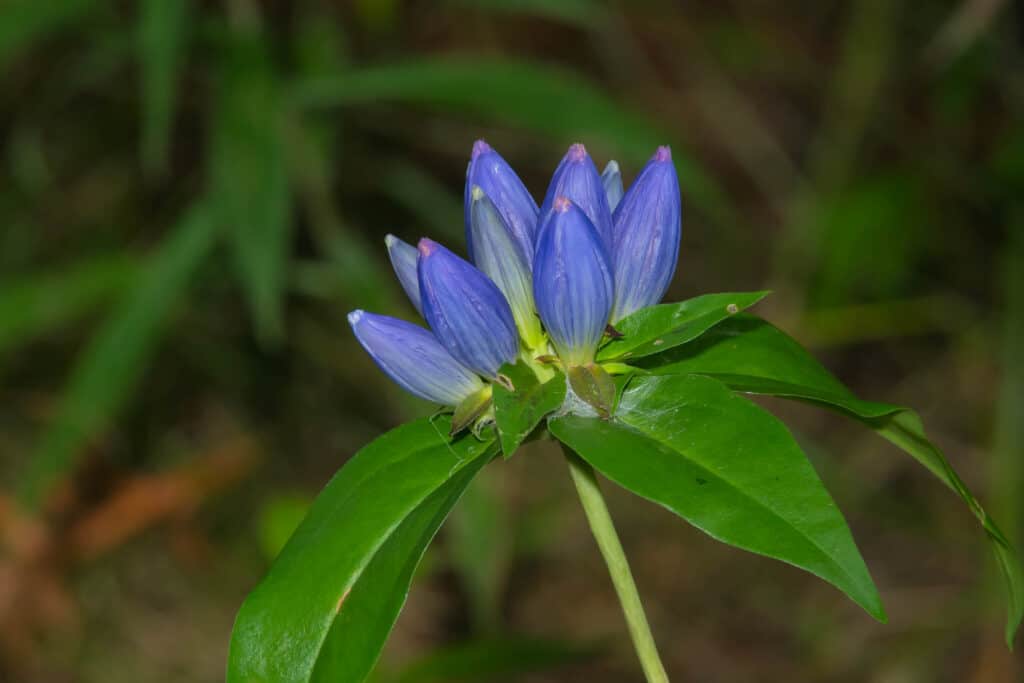
Gentian flowers bloom from late summer into early fall.
©iStock.com/PaulReevesPhotography
Clusters of purple or white flowers pop out on the North American plant known as Gentian. The flowers don’t actually open like others, so though they help pollinators for sure, the little insects and birds have to push their way in to get the pollen and nectar. The plant prefers woodland streams and ponds, with rich, moist, well-draining soil. Partial shade helps them thrive in Hardiness Zones 7 and above, with mild temperate climates ideal.
Globe Amaranth (Gomphrena globose)
A tropical plant native to pretty much all of Central America, the globe amaranth offers stunning white, purple, or pink blooms. The plant is an annual, meaning you’ll need to save the seeds and replant each year. They grow up to between 1 and 2 feet in height, and push out those spherical blooms on long, rigid stalks. The plants thrive in Hardiness Zones 2 through 8 when properly cared for.
Germander Shrub (Teucrium Fruticans)
A perennial, evergreen shrub, Germanderor Teucrium Fruticans produce vivid blue or violet flowers year after year. The hardy plant prefers soil with a pH between 6.1 and 7.8 and handles dry to medium moist soil in full sun as its preference. Hardiness Zones 8 to 10 keep the plant healthy and perennial, but you can grow them in containers or annuals in cooler climates. The showy plant tolerates drought fairly well, which makes it particularly favorable in the American Southwest and in xeriscaping garden settings.
Giant Hyssop (Agastache)
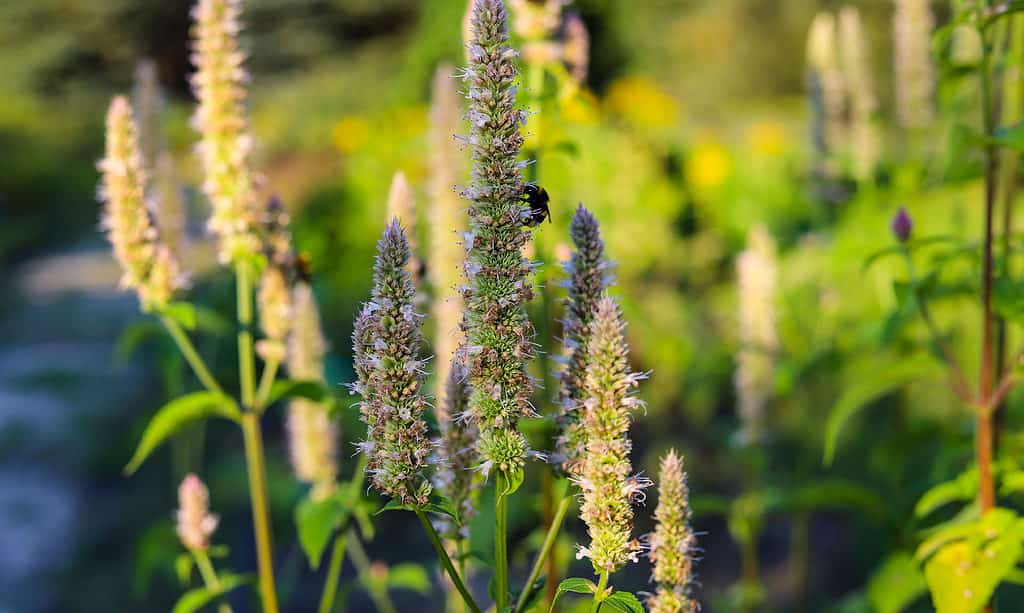
Yellow giant hyssop is commonly found in central and eastern regions of the United States and Canada.
©Kabar/Shutterstock.com
Giant hyssop, or Agastache, produces stunning whorled blooms in many colors from white and orange to pink, mauve, blue-ish purple, or deep purple. The plant grows gray-green to green foliage with aromatic properties that hummingbirds and other pollinators love. Giant hyssop comes back year after year as long as it has moderate moisture, soil pH 6 to 8, and full sun to partial shade. This herb thrives in Hardiness Zones 5 to 9.
Goat’s Beard or Bride’s Feathers (Aruncus)

Goat’s beard or bride’s feathers offer unique beauty.
©Brzostowska/Shutterstock.com
Belonging to the Rosaceae or rose family, the perennial Aruncus known commonly as either goat’s beard or bride’s feathers offers some unique and stunning beauty. The pinnate clusters of blooms come in creamy shades, growing on long thready spikes from May to mid-July. The gorgeous flowers offer some brightness and height in the flower bed and blend beautifully with a mixture of other flowers in various heights and colorations.
Golden Knee (Chrysogonum virginianum)
A popular groundcover flower that starts with G is Golden Knee or Chrysogonum virginianum. The perennial produces stunning yellow flowers on plants that reach 3 to 4 inches in height at maturity. These beauties do well in full sun to full shade, making them a hugely versatile plant, as well. Provide them with soil that’s 6 to 7.5 pH and keep the soil medium to wet on moisture levels.
Gooseneck Loosestrife (Lysimachia clethroides)
Needing moderate moisture and soil pH of 6 to 8, the perennial Gooseneck loosestrife, or Lysimachia clethroides, blooms white flowers in a long “tail” like shape that truly catch the eye. They handle rabbits – so perfect for places like Chicago where those critters run wild! – while offering incredibly showy blooms. Gooseneck loosestrife thrive in a range of light conditions from full sun to partial shade. Most often, they’re planted as groundcover but they can be enjoyed as specimen plants as well, when situated properly. They thrive in Hardiness Zones 3 to 8 and reach heights between 24 and 36 inches.
Garden Angelica (Angelica archangelica)
Angelica archangelica (roughly translated archangel angel) offers some splendid beauty wherever it grows. The unique blooms come in double compound umbel inflorescence with loads of tiny white flowers. The inflorescences are about 1 inch across, with each tiny bloom looking a bit like stars. These stunning plants love direct sunlight and moist soil, so need daily watering in summer in hotter climates.
Globe Thistle (Echinops)

Globe thistle attracts pollinators.
©Alex Manders/Shutterstock.com
A beautiful perennial for the container or raised bed garden, globe thistles are best kept away from walking paths. Echinops thrive practically anywhere you plant them in any kind of soil. The plant is painful if it comes into contact with the skin, but the deep purple or blue blooms add some stunning aesthetics to the garden. They also offer some lovely food for the local pollinators.
Golden Chamomile (Anthemis tinctoria)
Commonly referred to as golden chamomile, the Anthemis tinctoria welcomes the sun year after year as a drought-tolerant perennial flower. The bright yellow blooms offer a fragrance perfect for the garden space, as a cut flower, or in containers. Preferring soil pH of 6.1 to 7.5, they need full sun to keep their evergreen foliage happy and thriving. Grow these in Hardiness Zones 3 to 7.
All the Flowers
A quick list for reference of the most commonly found beautiful flowers that start with G.
- Gardenia
- Geranium
- Gladiolus
- Gerbera
- Goldenrod
- Grape Hyacinth
- Gaillardia
- Gas Plant
- Gaura
- Gayfeather
- Genista
- Gazania
- Geum
- Gilliflower
- Giner
- Garden Stock
- Globeflower
- Glory of the Snow
- Gloxinia
- Godetia
- Globe Amaranth
- Germander Shrub
- Giant Hyssop
- Goat’s Beard
- Golden Knee
- Gooseneck Loosestrife
- Garden Angelica
- Globe Thistle
- Golden Chamomile
| Flower | |
|---|---|
| 1 | Gardenia |
| 2 | Geranium |
| 3 | Gladiolus |
| 4 | Gerbera |
| 5 | Goldenrod |
| 6 | Grape Hyacinth |
| 7 | Gaillardia |
| 8 | Gas Plant |
| 9 | Gaura |
| 10 | Gayfeather |
| 11 | Genista |
| 12 | Gazania |
| 13 | Geum |
| 14 | Gilliflower |
| 15 | Giner |
| 16 | Garden Stock |
| 17 | Globeflower |
| 18 | Glory of the Snow |
| 19 | Gloxinia |
| 20 | Godetia |
| 21 | Globe Amaranth |
| 22 | Germander Shrub |
| 23 | Giant Hyssop |
| 24 | Goat’s Beard |
| 25 | Golden Knee |
| 26 | Gooseneck Loosestrife |
| 27 | Garden Angelica |
| 28 | Globe Thistle |
| 29 | Golden Chamomile |
Thank you for reading! Have some feedback for us? Contact the AZ Animals editorial team.

